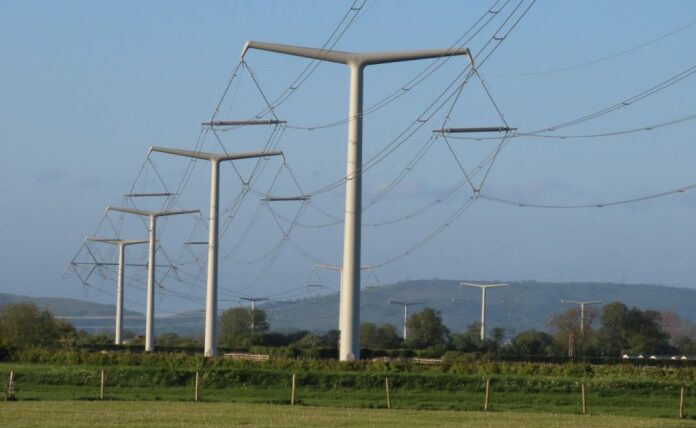National Grid has installed overhead conductors on all 116 of its new T-pylons, marking a new milestone for the Hinkley Point Connection Project.
The project spans 57km in total between National Grid’s new Shurton substation on the Hinkley Point C site and its existing Seabank substation in Avonmouth.
48.5km is made up of overhead lines – mostly T-pylons – while an 8.5km stretch of underground cable runs through the Mendip Hills Area of Outstanding Natural Beauty.
Stringing has been completed with the fixture of conductors to a T-pylon near the village of Yatton this month.
With each T-pylon supporting 12 conductors, it means that National Grid and its contractor Balfour Beatty have installed a total of 460km of power line between the T-structures – enough to stretch from Bridgwater to Paris.
T-pylons’ unique design sees six conductor spans attached to each diamond earring-shaped insulator on either side of the structure, with wires installed in sections of up to a dozen T-pylons at a time – a job that can take two weeks for each section.
Conductors were transported to each stringing site on large drums weighing up to seven tonnes and standing eight foot tall, before engineering teams set about hoisting the wires across the T-pylons.
With the help of a steel braided guide rope and circular running blocks suspended from the insulators, the heavy conductors are winched back through the running blocks, with engineers controlling the speed to precisely guide them into position and fix them to the insulators.
In total, around 1,288 tonnes of overhead conductor has been strung between the T-pylons – equivalent to three International Space Stations.
Steven Haskayne, project director for National Grid, said: “With the T-pylons fully strung, our Hinkley Connection Project is really starting to take shape. It’s a proud moment for all the teams involved, from our National Grid colleagues to our contractors, all of whom have helped us reach this milestone safely and on schedule.”
“We’re grateful to all of the local communities we’ve been working alongside for their patience as our project team continues its work, which is moving us closer to a resilient and secure low carbon energy supply for millions in the region.”
Tony Wilson, managing director of Balfour Beatty UK Power Transmission and Distribution, adds: “The efficient delivery of overhead power lines for the Hinkley Connect Project is a testament to our technical capabilities and reinforces our close partnership with National Grid to secure and deliver sustainable energy solutions.”
“As we look ahead, we remain committed to supporting National Grid projects, contributing to the creation of a resilient and secure low carbon energy supply for communities across the UK.”
T-pylons make up the majority of the Hinkley Connection Project’s 57km route through Somerset, with shorter sections of traditional lattice pylons at each end of the route at Shurton and Avonmouth – the latter to ensure safe height over the Port of Bristol area.
The energisation last year of an initial section of the route means high voltage electricity is already flowing through 36 T-pylons, a new National Grid substation at Sandford, and the underground cables through the Mendip Hills. All the remaining T-pylons will be energised by the end of 2024.
As part of the project, National Grid is also removing 67km of existing overhead lines and pylons – 249 in total – from the Somerset landscape. Over 30 pylons running parallel to the new undergrounded section in the Mendip Hills are being taken down, which will leave the landscape pylon-free for the first time in nearly a century.







